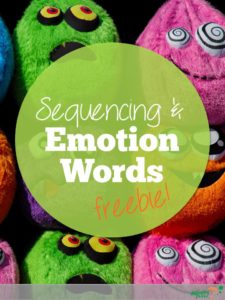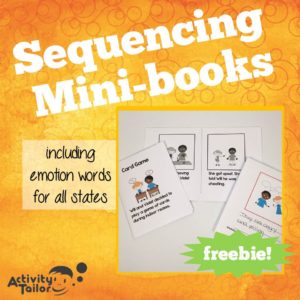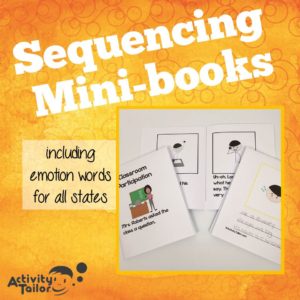Sequencing is one of those skills that we take for granted—of course you need to put toothpaste on the toothbrush before you brush your teeth—but most of our little ones need explicit instruction to fully comprehend the beginning, middle and end of an event or activity. Does it really matter?
How important is sequencing?
Well, very. Understanding the sequence of events can help us:
• Follow directions
• Recognize patterns
• Anticipate outcomes
• Understand cause and effect
• Organize and integrate new information
• Regulate our mood or state
Understanding sequencing is a critical pre-reading skill that eventually allows us to:
• Comprehend stories
• Retell events
• Organize thoughts and ideas in writing
My little ones often need lots of practical activities to work on these concepts and I’ve shared several of these before like Sequencing Journals and Postcards.
But more and more, I’m finding that my kiddos particularly need support to understand the feelings that might be associated with a sequence of events. By including emotions in our stories we can rehearse for upcoming activities and discuss how we might handle those changes in mood or state. For example, our story might start with a child who is playing/working quietly in the classroom and then the fire alarm goes off. Next, we see the child in a terrified state. This sets the stage for problem solving what could happen next.
Including emotions in our stories is also a way to highlight how our behavior impacts the feelings of others. For instance, we might have a group of children playing soccer and another alone on the basketball court feeling lonely and left out. We can talk about the importance of including others or being more flexible by joining a group even when it’s not a preferred activity. Or we might simply validate that sometimes situations like this arise and feeling lonely or disappointed is expected.
• Stopping periodically during read-alouds to check in and ask how different characters might be feeling is one way to address this goal. In the midst of a rollicking read of The Cat in the Hat, pause to look at the expressions on the children’s faces. Are they as excited as the Cat? Are they anticipating something that might happen that causes them to look that way?
• Act out simple stories, like the Three Little Pigs, and have your students focus on the facial expression as much as the sequence itself. Pigs are scared when the wolf knocks on the door and the wolf might look frustrated or angry when the pigs keep escaping.
• Add your own emotions to classroom sequences, “After snack, we will go to the theater to watch the third grade play. That makes me feel excited.” or “My best friend visited me this weekend. We talked and went to the movies. Then, she went back home and now I’m feeling sad.”
I’ll be using mini-sequencing books with my students this fall both to provide a visual for support, but also as an activity they can bring home to share. Think you could use these too? Click here for your free sample.
Click here or on the cover below to view the entire product.








